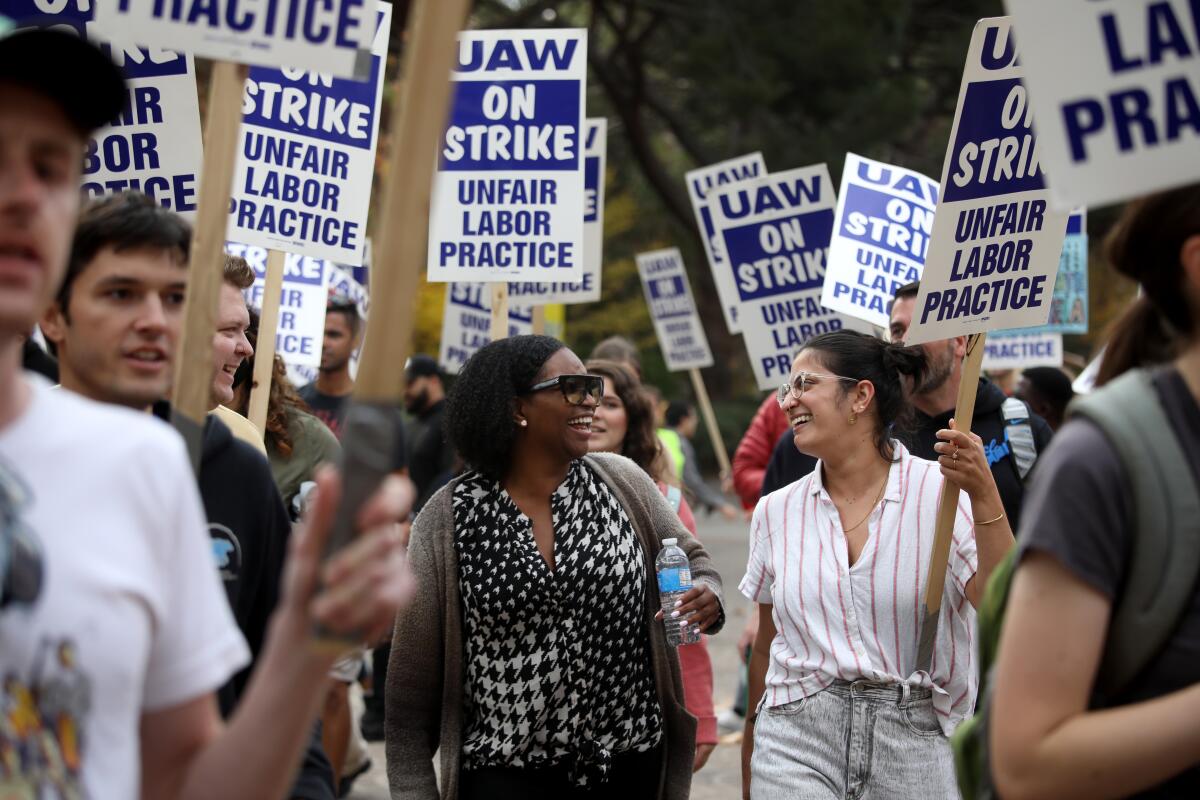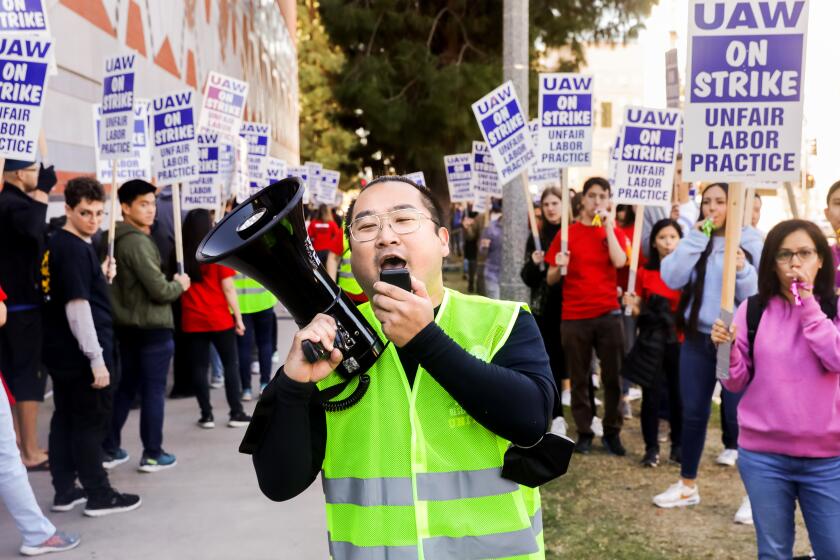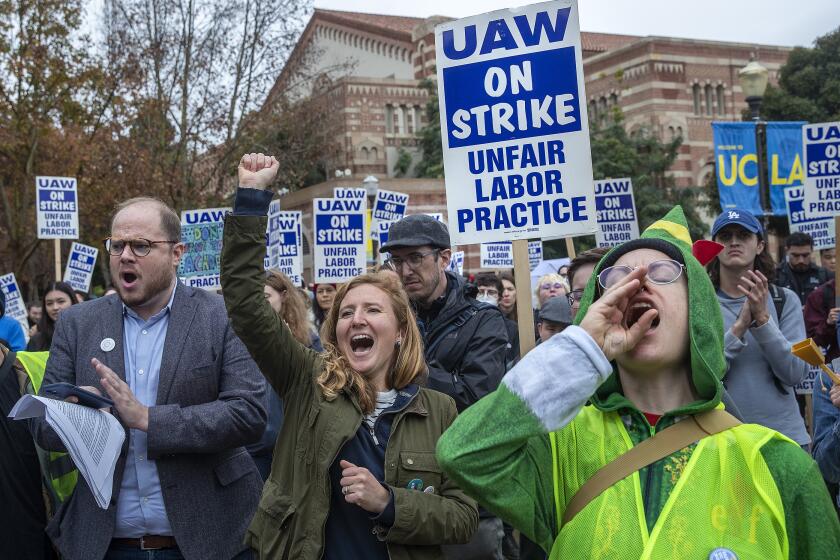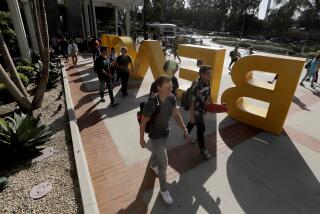To afford historic labor contract, UC considers cutting TAs, graduate student admissions

- Share via
Just weeks after the University of California and academic workers heralded historic wage gains in new labor contracts, the question of how to pay for them is roiling campuses, which are scrambling to identify money, considering cutbacks in graduate student admissions and fearing deficits.
The full financial cost of the labor settlements between UC and 48,000 academic workers who help power the vaunted teaching and research engine are still being tallied. But preliminary estimates have dealt a “financial shock to the system,” said Rosemarie Rae, UC Berkeley chief financial officer.
The UC Office of the President estimates that the increased costs for salary, benefits and tuition across all 10 campuses will be between $500 million and $570 million over the life of the contracts. Individual campuses have come up with their own calculations: At UC Santa Barbara, for instance, the Academic Senate chair estimated that the cost of pay hikes alone could spiral to more than $53 million over three years.
Overall, the costs take in pay increases of 20% to 80%, depending on the workers — teaching assistants, tutors, researchers and postdoctoral scholars — and are among the highest ever granted in the nation’s universities.
“It’s a huge number,” UC Board of Regents Chair Rich Leib said. “I think it was a good agreement, and I’m happy with that. But there are ramifications. It’s not like the money’s coming from the sky. We’re trying to figure it out, but it’s going to require changes.”
Options are limited, with no new state influx of money in the coming academic year dedicated to covering the raises when they kick in — and the state is facing a projected $22.5-billion budget deficit. Fixed federal contracts that pay for 60% of the academic workers can’t be abruptly renegotiated. Many campuses have raised questions as to why UC negotiated the contracts without identifying a clear funding source.
About 48,000 unionized academic workers across the University of California’s 10 campuses walked off the job, calling for better pay and benefits.
“We were in a difficult situation,” Leib said. “You have graduate students who were really hurting in the face of housing costs. It’s not really feasible to say, ‘As soon as we get the money, we’ll let you know.’ It’s one pressure after another.”
Funding the raises could touch off far-reaching changes to UC’s traditional model of graduate student education, including potential reductions of teaching assistants and researchers. Decreasing their numbers could have a cascading effect by narrowing the pipeline for future faculty and industry innovators, affecting research output and diluting the learning experience of undergraduates with potentially larger class sizes and less personalized instruction.
“The state of California needs more highly trained people, and we’re going in the opposite direction,” said Susannah Scott, a UC Santa Barbara chemical engineering professor and chair of her campus Academic Senate. “People are very worried.”
Leib and other UC leaders, administrators and faculty emphasize that they support the wage and benefit gains to help academic workers live in the pricey neighborhoods where campuses are located.
For academic student employees, the new contract will raise minimum pay from about $23,250 to about $34,000 for nine months of part-time work by Oct. 1, 2024, with rates topping $36,000 at UC Berkeley, UC San Francisco and UCLA. Graduate student researchers will make a minimum of $34,564 for nine months of part-time work by Oct. 1, 2024.
Postdoctoral scholars will receive an increase in minimum annual pay for their full-time positions from about $55,000 to $70,000 or higher with various adjustments by the end of the five-year contract. Contracts for graduate student workers run through May 2025 and extend two years longer for the others.
So far, UC has not sent campuses any systemwide game plan to handle the raises — fueling frustration among faculty members that they’ll be left to figure out solutions using their own funds to pay for labor negotiations they say they had little, if any, opportunity to shape.
UC spokesman Jorge Silva said President Michael V. Drake’s office collaborated with key campus and faculty representatives, including the Academic Senate, throughout the bargaining process.
“The Office of the President will continue to work with our campuses to implement these generous contracts ... and be responsive to their unique structures and needs,” he said in an email.
UC Chief Financial Officer Nathan Brostrom said some funding is available for researchers and postdoctoral scholars, whose jobs are generally supported by federal grants obtained by faculty. But faculty will need to incorporate the larger price tags in their contract renewals, he said.
Brostrom added that UC will build into future budgets the higher costs for teaching assistants, who are paid with state funds.
But he told regents at their meeting this month that a “mismatch” between rising labor costs, insufficient revenue to pay for them and inflation could tip campuses into budget deficits in coming years.
In an interview with The Times, he said UC has finally achieved some budget stability with one-time tuition increases for each incoming class and Gov. Gavin Newsom’s pledge to provide a 5% annual base budget increase over five years, but rising expenses are a concern that must be addressed.
Faculty say they hope the funding crisis will train the attention of UC regents — who have focused on undergraduates — toward the pressing needs of graduate students.
In remarks this month, systemwide Academic Senate Chair Susan Cochran told regents that UC produces 63% of California’s PhDs — who are more diverse than their national counterparts, primarily employed in high-paying STEM fields and act as catalysts for the state’s economy.
But “exceptionally weary” faculty fear that asking them to continue to shoulder the task of financing graduate students through grants they obtain and other means is unsustainable, she said. Senate leaders have raised alarms for two decades about the need to reform graduate student funding models, with little success.
The massive and successful strike by University of California academic workers has helped energize an unprecedented surge of labor organizing among their peers nationwide.
“If we can no longer afford to admit and support many of these individuals,” Cochran said, “we will be constraining what has been a path of upward mobility for Californians and a source of economic vitality for the state.”
Many faculty members are demanding more support. At UCLA, more than 260 have signed a letter opposing any move by Drake and campus administration to impose the costs of the contracts on “the already strained finances of departments, research centers and faculty.”
The letter said that faculty in some departments, such as the Luskin School of Public Affairs, have already been told that no additional funds are anticipated to cover the higher costs of teaching assistants in fall 2023, when significant salary increases kick in.
The Division of Social Sciences is facing $10 million in higher academic worker costs over three years; interim Dean Abel Valenzuela told faculty that departments would be asked to absorb the cost, according to Grace Hong, a professor and director of the Center for the Study of Women who attended a Jan. 10 meeting at which the issue was discussed. Valenzuela did not respond to a request for comment.
The result of such “punitive austerity,” the letter said, will be a “reduction of graduate student appointments; an increase in the already high number of undergraduates per discussion section, and a correspondingly negative impact on course curriculum, undergraduate assignments and grading; the weakening of currently funded research; and ultimately fewer funded research opportunities for graduate students.”
The letter, sponsored by the UCLA Faculty Assn., called on UC leaders to reallocate administrative budgets and other funds, such as $4 billion recently invested in controversial private equity giant Blackstone Inc., and appeal for more public funding from state and federal officials.
“The systemic problems of the university are being left at the doorstep of individual faculty and departments,” said Toby Higbie, a history professor who signed the letter. “But you can’t squeeze that stone anymore.”
Academic worker leaders also expressed alarm over potential cuts in teaching assistants and graduate student admissions. In a letter to Drake on Thursday, Rafael Jaime of UAW 2865 and Neal Sweeney of UAW 5810 told Drake that such potential reductions were “not compatible with the excellence in teaching and research for which the University of California is famous” and would counter pledges made to increase the number of graduate students by 2,500 under a multiyear plan with the governor.
In a survey by UAW 2865, graduate workers from 89 departments across all 10 campuses indicated that they had been informed of plans to reduce enrollment for the 2023-24 academic year. They also heard of plans to increase class sizes and shrink research groups.
The survey reported specific cuts at UC Davis in such fields as music and physics and at UC Irvine in drama, political science, Earth systems science and urban planning. UCLA will trim admission to the psychology program from 36 spots to 24, according to students who quoted an email from the department chair.
UCLA spokesman Bill Kisliuk said campus leaders were discussing short- and long-term strategies to bridge the funding gap but declined to elaborate on them.
“Our goal is to set our academic workers and graduate education programs on the strongest possible long-term footing,” he said.
Kisliuk said no decision on future graduate student enrollment numbers has been made.
At UC Santa Barbara, Scott said her chemical engineering department is considering reducing admission offers to graduate students from 75 or 80 to about 50. Colleagues across campus are also being “super conservative” about taking on more students, she said. Scott added that such reductions would hit early-career faculty particularly hard, because they need strong graduate students to help establish research programs. Smaller graduate programs could “grind to a halt” if deprived of new students, she said.
UC Irvine is weighing reductions in graduate student admissions by at least 30%, sources told The Times.
“We are still very early in the admissions process, but it is likely that programs will be cautious about enrollment this year as the faculty work to better understand how best to support our PhD students,” campus spokeswoman Sheri Ledbetter said in a statement.
UC Riverside estimates increased costs of about $28 million through fiscal year 2025, with the largest chunk — $15 million — for teaching assistants, tutors and readers. Gerry Bomotti, vice chancellor for planning, budget and administration, said the campus will not reduce new graduate student admissions this fall, because it is too late in the recruiting cycle, and will cover added costs with one-time funds. A more sustainable plan will be developed for future years, he said.
At UC Berkeley, chemistry professor Ron Cohen said he is waiting to see if he can afford to bring on one or two more PhD students to join his team of six. Rae, the campus chief financial officer, said the wage increases could not be easily absorbed into Berkeley’s budget — which has fallen into major deficits twice since 2016 — and deans and department chairs were being advised to “carefully consider graduate admissions.”
Cohen, however, said he remains upbeat about the university’s future.
“The University of California is an incredibly strong, resilient place,” he said. “It will continue to thrive.”
More to Read
Sign up for Essential California
The most important California stories and recommendations in your inbox every morning.
You may occasionally receive promotional content from the Los Angeles Times.













